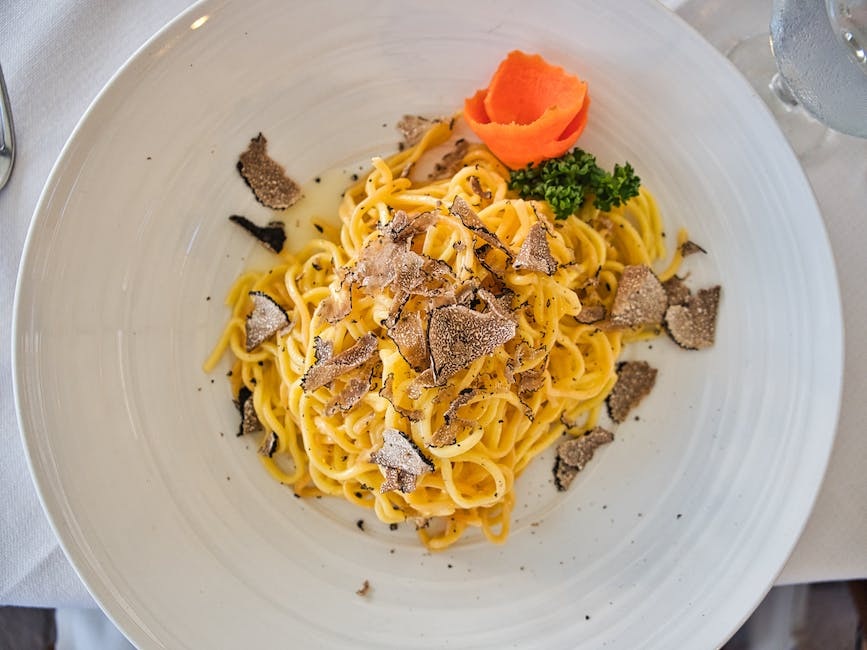Introduction to Oolong Noodles
Are you a tea lover looking to add a unique twist to your meals? Look no further than oolong noodles! Oolong noodles are a delicious and easy-to-make dish that combines the earthy and floral flavors of oolong tea with the comfort of a warm bowl of noodles. Whether you’re a beginner in the kitchen or an experienced chef, this recipe is sure to impress your taste buds and leave you craving for more.
Originating in China, oolong tea is known for its complex taste and numerous health benefits. By incorporating oolong tea into your noodles, you not only elevate the overall flavor profile but also add a touch of richness and depth to the dish. So, let’s dive in and learn how to make oolong noodles that will transport you to a culinary paradise.
Before we start cooking, let’s gather our ingredients and make sure we have everything we need to create this delightful dish.
Ingredients Required for Oolong Noodles Recipe
To make a delicious batch of oolong noodles, you’ll need the following ingredients:
- 2 cups oolong tea
- 8 ounces noodles (choose your favorite type, such as udon or soba)
- 2 tablespoons soy sauce
- 1 tablespoon sesame oil
- 1 tablespoon rice vinegar
- 1 tablespoon honey or maple syrup (for a touch of sweetness)
- 2 cloves garlic, minced
- 1-inch piece of ginger, grated
- 1 cup sliced vegetables (carrots, bell peppers, and snow peas work well)
- 1 cup sliced mushrooms
- 1 tablespoon cornstarch mixed with 2 tablespoons water (for thickening, optional)
- Salt and pepper to taste
These ingredients can be easily found at your local grocery store or Asian market. Feel free to customize the recipe by adding or substituting vegetables and protein according to your preferences. Now that we have our ingredients ready, let’s move on to the exciting part – cooking!
Step by Step Instructions to Cook Oolong Noodles
Follow these simple steps to create a delectable bowl of oolong noodles:
- Start by boiling water in a medium-sized pot. Once the water comes to a boil, add the oolong tea and let it steep for about 5 minutes. Strain the tea and set it aside.
- In a separate pot, cook the noodles according to package instructions. Once cooked, drain the noodles and rinse them with cold water to prevent sticking. Set aside.
- In a large skillet or wok, heat the sesame oil over medium heat. Add the garlic and ginger, and sauté for a minute until fragrant.
- Add the sliced vegetables and mushrooms to the skillet and stir-fry for about 2-3 minutes until they start to soften.
- In a small bowl, whisk together the soy sauce, rice vinegar, and honey/maple syrup. Pour this sauce mixture over the vegetables in the skillet and stir well to coat everything evenly.
- Add the brewed oolong tea to the skillet and bring it to a simmer. Let the flavors meld together for a couple of minutes.
- If you prefer a thicker sauce, add the cornstarch-water mixture to the skillet and stir well. Allow the sauce to thicken slightly.
- Finally, add the cooked noodles to the skillet and toss them with the vegetables and sauce, ensuring they are well-coated.
- Season with salt and pepper to taste, and give it one final toss to combine all the flavors.
- Remove from heat and serve your steaming hot oolong noodles in bowls, garnished with a sprinkle of sesame seeds or fresh cilantro.

There you have it! Your scrumptious oolong noodles are ready to be enjoyed. The combination of the oolong tea-infused flavors and the blend of textures from the noodles and vegetables create a truly delightful dish. Now that we know how to cook the basic recipe, let’s explore some tips and tricks to enhance the flavor even further.
Tips and Tricks to Enhance the Flavor of Oolong Noodles
While the basic recipe for oolong noodles is already delicious, here are some tips and tricks to take the flavors to another level:
- Experiment with different oolong tea varieties. Each oolong tea has its distinct flavor profile, ranging from floral to fruity to toasty. Try using different types of oolong tea to find your favorite combination.
- Marinate your protein of choice in a mixture of soy sauce, ginger, and garlic before cooking. This step adds another layer of flavor to the dish.
- Add a splash of lime juice or rice vinegar at the end to add a tangy kick to the noodles.
- If you like a bit of heat, add some red pepper flakes or sliced chili peppers to the stir-fry for a spicy twist.
- For a touch of umami, sprinkle some sesame seeds or drizzle a bit of sesame oil on top of the noodles before serving.
- To make your oolong noodles more filling, add protein such as tofu, shrimp, or thinly sliced chicken. Sautee them separately and add them to the noodles towards the end.
- If you’re feeling adventurous, experiment with other vegetables such as bok choy, bean sprouts, or even baby corn. The more colorful and varied the vegetables, the more visually appealing your dish.
- For a creamier sauce, add a tablespoon of peanut butter or tahini when whisking the sauce ingredients together.
- Remember to adjust the salt and pepper according to your taste preferences. If you enjoy a bit of sweetness, you can increase the amount of honey or maple syrup in the recipe.
- Lastly, don’t be afraid to get creative and make the recipe your own. Feel free to add additional herbs, spices, or condiments that you love to make the flavors uniquely yours.
By incorporating these tips and tricks, you can elevate the taste of your oolong noodles and make them an unforgettable culinary experience. Now, let’s explore some possible variations of the oolong noodles recipe to add even more excitement to your mealtime!
Possible Variations of Oolong Noodles Recipe
While the basic recipe for oolong noodles is delicious on its own, there are endless possibilities for variations. Here are a few ideas to inspire you:
- Spicy Oolong Noodles: Add sliced jalapenos or chili paste to the stir-fry for a spicy kick. You can also garnish with fresh cilantro or chopped scallions to balance the heat.
- Citrus Oolong Noodles: Squeeze fresh lemon or orange juice over the dish to add a bright and tangy flavor. You can also zest some citrus peel and sprinkle it on top for an extra burst of freshness.
- Peanut Oolong Noodles: Stir in a tablespoon or two of smooth peanut butter into the sauce mixture for a creamy and nutty twist. Top with crushed peanuts for added crunch.
- Coconut Curry Oolong Noodles: Replace the soy sauce with coconut milk and add a teaspoon of curry powder to the stir-fry for a delightful fusion of flavors. Don’t forget to garnish with fresh cilantro for that authentic curry touch.
- Sesame Ginger Oolong Noodles: Increase the amount of ginger in the recipe and drizzle some extra sesame oil before serving. The combination of these two ingredients gives a warm and comforting flavor to the dish.
- Garlic Mushroom Oolong Noodles: Focus on the umami-packed mushrooms by using a mix of different varieties like shiitake, cremini, and oyster mushrooms. Sauté them with extra garlic and splash in some Worcestershire sauce for depth of flavor.
- Green Tea Oolong Noodles: Substitute some of the oolong tea with green tea to create a more herbal and grassy flavor profile. Garnish with fresh basil leaves for a refreshing twist.
- Asian-inspired Oolong Noodle Salad: Cool down the dish by tossing the cooked noodles with fresh cucumber ribbons, shredded carrots, and a tangy dressing made with soy sauce, ginger, rice vinegar, sesame oil, and a touch of honey.
These are just a few ideas to get you started, but don’t hesitate to get creative and experiment with flavors that you love. Oolong noodles are incredibly versatile, so feel free to add your favorite ingredients and seasonings to make a dish that suits your taste buds perfectly.
Now that you have mastered the art of making oolong noodles and explored various options to customize the recipe, it’s time to serve and enjoy this delicious creation!
Conclusion and Serving Suggestions for Oolong Noodles
Congratulations! You have now learned how to make scrumptious oolong noodles from scratch. This unique and flavorful dish combines the aromatic notes of oolong tea with the comforting texture of noodles, creating a truly delightful culinary experience.
When it comes to serving oolong noodles, there are a few suggestions that can elevate your meal even further:
- Serve the noodles hot and steaming in bowls for a cozy and satisfying meal. The warmth of the noodles will help release the aroma of the oolong tea and intensify the flavors.
- Garnish your oolong noodles with fresh herbs like cilantro or green onions for a burst of freshness and added visual appeal. You can also sprinkle some toasted sesame seeds or chopped peanuts for extra texture.
- Pair your oolong noodles with a side of steamed vegetables or a refreshing salad to create a well-rounded and nutritious meal. The lightness of the vegetables will complement the rich and flavorful noodles.
- If you want to add a protein element to your meal, consider serving the oolong noodles alongside grilled shrimp, pan-seared chicken, or tofu. The protein will add substance and make the dish more filling.
- For a complete Asian-inspired feast, serve oolong noodles alongside other dishes like spring rolls, dumplings, or stir-fried vegetables. This will create a harmonious and balanced meal that captures the essence of Asian cuisine.
- Don’t forget to pair your oolong noodles with a cup of oolong tea to enhance the tea flavor and create a seamless dining experience. The tea will complement the noodles and create a harmonious blend of flavors.
Now that you have the knowledge and tools to create oolong noodles, it’s time to get into the kitchen and give it a try. Whether you’re cooking for yourself, your family, or guests, this dish is sure to impress. So, put on your apron, boil that water, steep that tea, and let the aroma of oolong tea fill your kitchen. Enjoy the journey and the delicious end result!


Leave a Reply